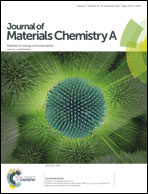Low effective mass leading to an improved ZT value by 32% for n-type BiCuSeO: a first-principles study
Abstract
BiCuSeO is an attractive material for its high temperature stability, high Seebeck coefficient, and low lattice thermal conductivity. However, its electrical conductivity is low. To enhance the thermoelectric properties of BiCuSeO further, we investigated the material's electronic structure and transport property using first-principles calculations. We determine that the low electrical conductivity may originate from strong ionic bonding and without a Cu–Se conductive pathway forming near the Fermi level. Moreover, although p-type BiCuSeO has a high thermopower due to the high density of states near the Fermi level, its electrical conductivity is relatively low because no conductive pathway for carrier transport exists along the c axis. In contrast, a conductive pathway is formed between Bi and Cu atoms at the conduction-band minimum along the c axis. This feature would lead to high electrical conductivity for n-type BiCuSeO. With relatively high electrical conductivity and slightly decreased thermopower, n-type BiCuSeO exhibits a higher power factor than that of p-type BiCuSeO. The maximum ZT value could be improved by 32% for n-type BiCuSeO compared with the prevailing p-type doping approach at 920 K.


 Please wait while we load your content...
Please wait while we load your content...